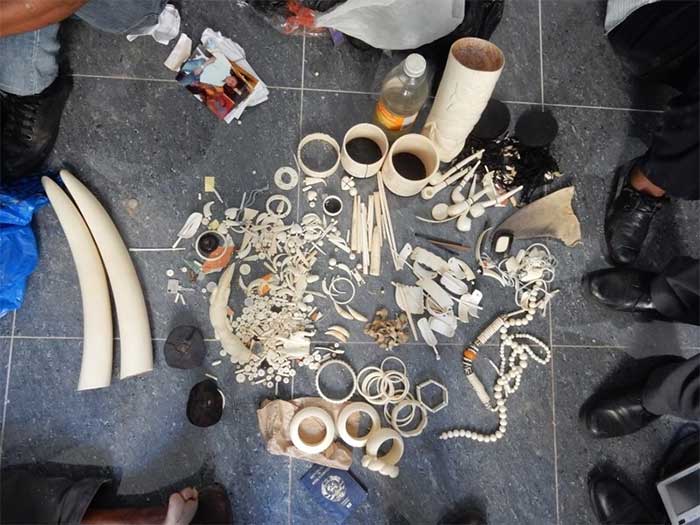A recent study by the Wildlife Conservation Society (WCS) has revealed that samples collected from wild animals at farms, markets, and restaurants, as well as from illegally traded products, have detected many new infectious viruses, including five coronaviruses, two herpes viruses (responsible for chickenpox, herpes, and shingles), and 14 Rhabdoviruses (which cause rabies). The exploitation of wildlife for consumption could expose humans to numerous infectious disease outbreaks.
A new study conducted by scientists from the Wildlife Conservation Society (WCS) published in the journal Frontiers in Public Health in 2022 concluded that confiscated pangolins from illegal wildlife trade in Vietnam tested positive for coronaviruses related to the SARS-CoV-2 strain.

Exploitation of wildlife could expose humans to numerous infectious diseases. (Illustrative image).
The study was conducted on 246 pangolins confiscated from wildlife trafficking cases in Vietnam between 2016 and 2018. Samples taken from seven pangolins in 2018 tested positive for coronaviruses related to the SARS-CoV-2 virus.
Ms. Nguyễn Thị Thanh Nga from WCS Vietnam, the lead researcher of the study, stated that the findings provide evidence that transnational wildlife trafficking can facilitate the spread of coronaviruses and other infectious viruses within the trade chain.
According to WCS, from 2018 to September 2023, Vietnam recorded over 1,000 wildlife seizure cases (approximately 114 wildlife species), involving more than 21,000 individual animals, body parts, and wildlife products; totaling 110.1 tons of wildlife parts and products.
Commonly exploited species include king cobras, Java pangolins, tigers, bears, and civets. The most common violations include trading (42%), transporting (37%), storing (16%), breeding (7%), hunting and killing (7%), importing (2%), advertising (1%), and 7% of cases with unspecified violations.
The organization’s experts discovered pathogens that can be transmitted between humans and animals within the wildlife supply chain. Specifically, there are 157 pathogens known to be transmitted between humans and animals, with 116 pathogens found in wildlife and 54 in domesticated animals.
After ten years of research evaluating high-risk species such as primates, bats, rodents, and carnivores, the researchers focused their testing on pathogens capable of crossing the species barrier: coronaviruses (causing diseases such as SARS, MERS, and COVID-19) found five new viruses and nine known viruses primarily in farm, market, bat feces, restaurant, and trading environments.
Notably, the research group found bat-derived viruses in fecal samples and environmental samples from farmed rodents at wildlife farms.
Additionally, the research team also discovered two new herpes viruses (responsible for chickenpox, herpes, and shingles) and 14 new Rhabdoviruses (which cause rabies).
Another WCS study indicated a high percentage of coronaviruses in samples collected from wildlife species sold as food for humans, with a significant increase in positive rates for coronaviruses as wildlife is transported from traders to markets and ultimately to restaurants.

Seized items from illegal transportation of wildlife products.
The positive rate for coronaviruses is notably high in ground squirrels processed for human food. The positivity rate significantly increases along the supply chain from traders (21%), to markets (32%), and restaurants (56%). In two-thirds of the wildlife farms and 6% of the rodents raised on farms participating in the study, results also showed positive for coronaviruses.
Fecal samples from rodents at wildlife farming facilities also revealed the same type of coronaviruses found in bats and birds, indicating a sharing of habitats and/or virus transmission between species. Samples of rodents taken from “natural” habitats showed a coronavirus positivity rate of about 0-2%.
“The wildlife trade is bringing humans closer to many wild species capable of spreading coronaviruses. This leads to the risk of virus transmission within and between species and increases the possibility of viral strains combining. The supply chain of wildlife from farms and nature to restaurants creates countless opportunities for disease outbreaks,” cautioned WCS.
Therefore, only limiting activities such as slaughtering, commercial breeding, transporting, buying, selling, storing, processing, and consuming wildlife can prevent the risk of new infectious disease outbreaks.
Ms. Hoàng Bích Thủy, Director of WCS Vietnam Program, shared that to prevent potential future pandemics, it is crucial to minimize the risk of disease transmission from animals to humans at key points in the wildlife supply chain. Intervention measures must aim to significantly reduce both the number and diversity of wildlife species being traded, as well as the number of people involved in wildlife trafficking.




















































